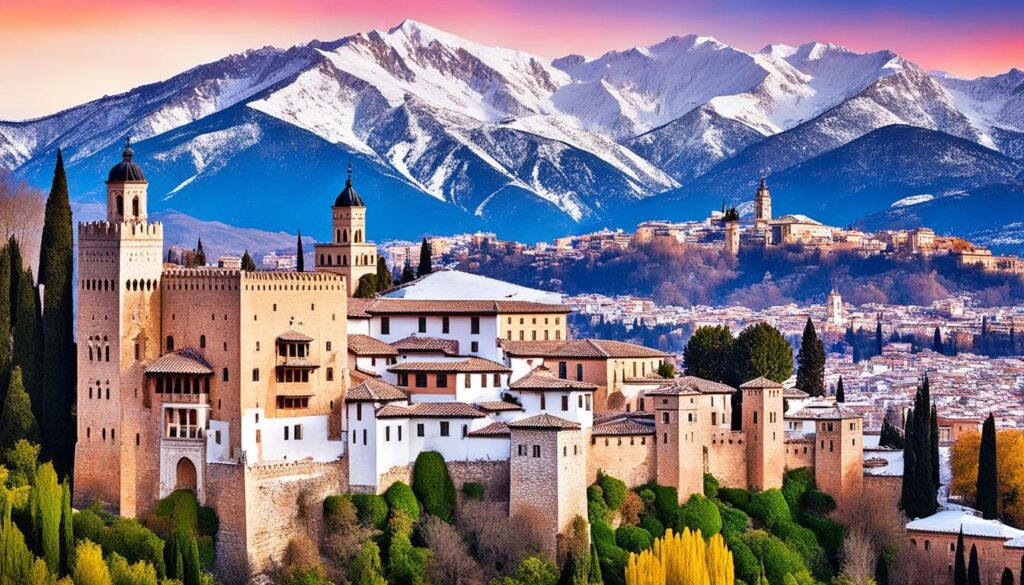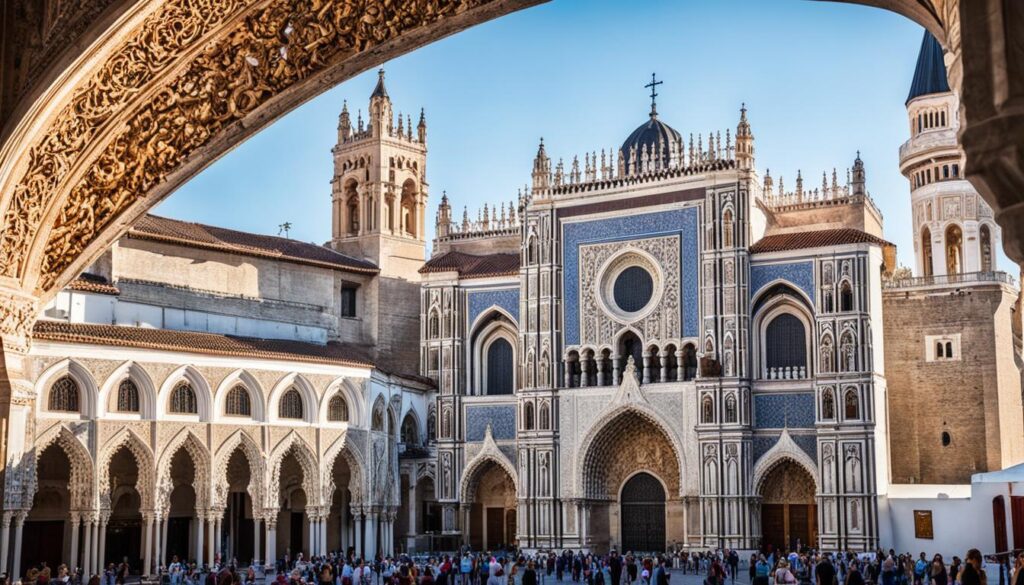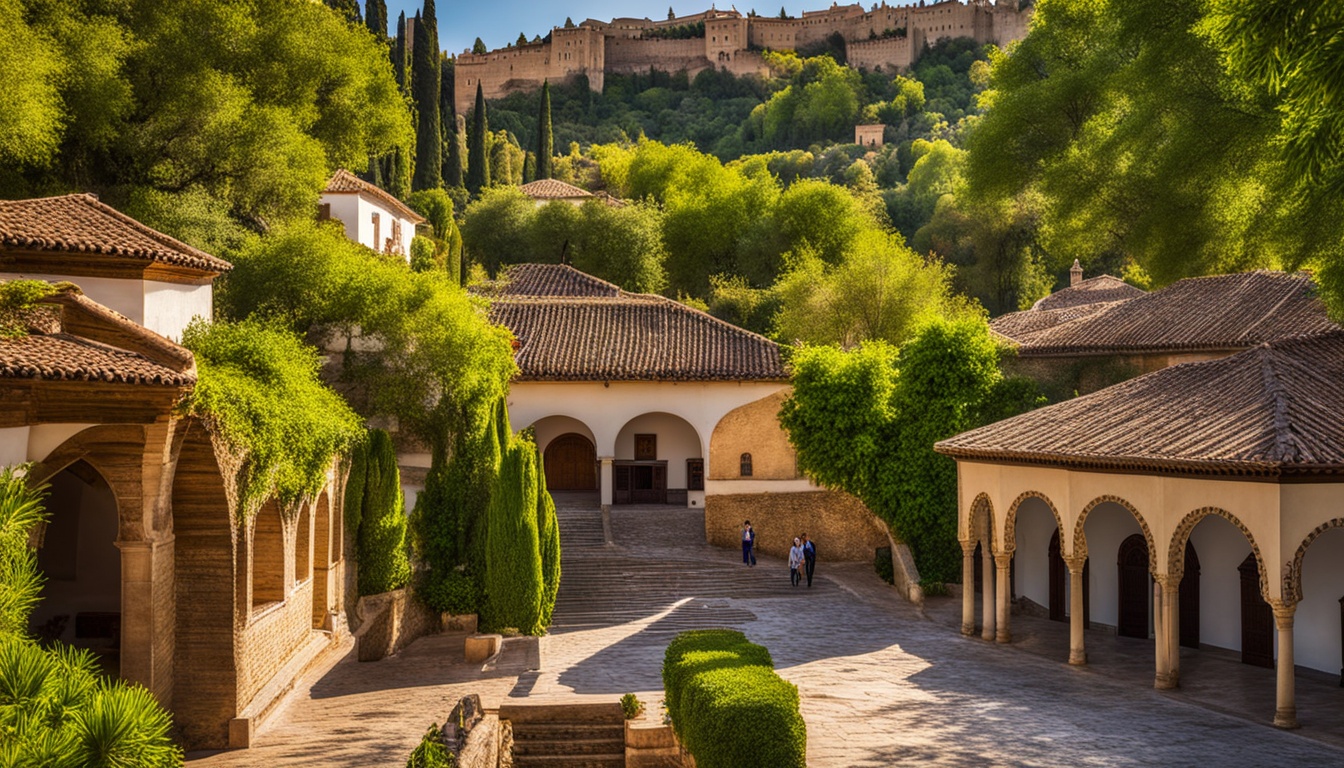Granada is a historic city in southern Spain, famous for its Moorish architecture and rich culture. It’s also known for its stunning natural beauty. Visitors can explore the Alhambra Palace and the charming Albayzín district. This guide will show you the top sights in Granada you can’t miss.
Key Takeaways
- The Alhambra and Generalife are the top attractions in Granada, with the Nasrid Palaces, including the Court of the Lions, being the most famous part.
- The Albayzín neighborhood is the oldest in Granada and offers spectacular views of the Alhambra.
- Carrera Del Darro is considered the most photographed street in Granada.
- The Sacromonte neighborhood is one of the oldest areas in the city and is known for its cave dwellings and flamenco shows.
- Granada’s historic and religious architecture, such as the Granada Cathedral and Monasterio de la Cartuja, are must-see attractions.
Granada’s Iconic Alhambra Palace
The Alhambra is the top attraction in Granada. It’s a Moorish fortress and palace from the 13th-14th centuries. It’s a UNESCO World Heritage site since 1984, known for its Islamic architecture and history.
The Palacios Nazaríes and Jardines del Partal
The Palacios Nazaríes, or Nasrid Palaces, are the Alhambra’s highlight. They show off Moorish design with detailed tilework and stucco. The Jardines del Partal, or Gardens of the Partal, offer a peaceful spot with greenery and water.
The Generalife Gardens
The Generalife Gardens are part of the Alhambra. They were the summer palace of the Nasrid rulers. These gardens have fountains, terraced gardens, and views of the city.
The Alcazaba Fortress
The Alcazaba Fortress is also part of the Alhambra. It’s a 10th-century military site with great views of Granada. Visitors can see the city and mountains from the Torre de la Vela.
“The Alhambra receives high visitation rates, with tickets often sold out weeks in advance.”
Visiting the Alhambra can take all day. It’s a chance to dive into the history and beauty of this famous Spanish site.
The Royal Chapel and Granada Cathedral
The Royal Chapel and Granada Cathedral sit next to the Alhambra’s grandeur. They are key religious sites in the city. They let visitors see Granada’s history and stunning architecture.
The Granada Cathedral shows off Spanish Renaissance beauty. It took 181 years to build, from 1523 to 1704. It’s Spain’s second-biggest cathedral and the first Renaissance one.
The Royal Chapel is home to the Catholic Monarchs, Ferdinand and Isabella. They conquered Granada from the Moors in 1492. Inside, there’s an altarpiece with 34 panels and a museum with royal artifacts.
At the Royal Chapel, you can see beautiful stained glass and paintings. The museum has Flemish, Italian, and Spanish art. It’s open to the public, with prices from 3.50 euros for students to 5 euros for adults. Kids under 12 get in free with an adult.
Visiting the Granada Cathedral and Royal Chapel is a journey through Granada’s history. These landmarks are a must for anyone visiting the city.
| Attraction | Admission Fee | Opening Hours |
|---|---|---|
| Royal Chapel of Granada |
|
|
| Granada Cathedral |
|
|
For more info, contact the Royal Chapel at capillarealgranada@gmail.com or 958 227 848.
“The Royal Chapel and Granada Cathedral are a testament to the city’s rich history and architectural grandeur. Their intricate details and captivating stories make them a must-see for any traveler to Granada.”
Exploring the Albayzín District
The Albayzín is Granada’s historic Moorish quarter, a UNESCO World Heritage site. It’s known for its winding, cobblestone streets and traditional architecture. This area has a rich history, with Iberians, Romans, Muslims, and Christians living there over the years.
Mirador San Nicolás Viewpoint
The Mirador San Nicolás is a famous spot in the Albayzín. It offers amazing views of the Alhambra palace and the Sierra Nevada mountains. People come here to see the Alhambra’s beauty against the snow-capped mountains.
Calle Calderería Nueva
Calle Calderería Nueva is another gem in the albayzin district granada. It’s a street filled with traditional calle caldereria nueva tea houses (teterías). Walking here, visitors can enjoy the Moorish vibe, sip fragrant teas, and take in the historic sights and sounds.
“The Albayzín is a labyrinth of narrow streets, steep slopes, and hidden corners, offering a glimpse into Granada’s captivating Moorish past.”
Exploring the Albayzín’s lanes and finding its hidden spots is a must for visitors to mirador san nicolas Granada. From the Mirador San Nicolás to Calle Calderería Nueva, this area charms with its history, beauty, and authentic Andalusian feel.
Sacromonte: Granada’s Gypsy Quarter
Beyond the famous Alhambra, Granada’s Sacromonte neighborhood shows off the city’s lively Gypsy (gitano) culture. This area is famous for its cave homes and the vibrant flamenco scene.
In the 1960s, Sacromonte was booming with life, having 1,500 cave houses and thousands of families. Now, many caves are now tourist spots, but some still run as flamenco venues called zambras.
Cave Dwellings and Flamenco Shows
People can check out the sacromonte caves and see real flamenco shows in these cozy spots. The Flamenco Tablao Jardines de Zoraya is known for its amazing flamenco shows. You should book your spot ahead of time.
Don’t miss the Sacromonte Abbey and its stunning views over Granada. A guided tour here costs 5 euros. It’s a great way to learn about the area’s history and culture.
The Sacromonte Museum gives a deep dive into the Gypsy residents’ lives. It has 11 caves that show their traditional way of living.
If you like flamenco shows granada or the sacromonte granada cave homes, this area is a must-see. It offers a real and engaging experience in the heart of Granada.
The Charming Carrera del Darro and Paseo de los Tristes
The Carrera del Darro is a beautiful street at the Alhambra and Albayzín’s foot. It’s known as the “most photographed street in Granada.” This path goes by the Darro River, leading to the calm Paseo de los Tristes. This walkway offers amazing views of the Alhambra.
The Carrera del Darro is filled with 16th and 17th-century buildings and Arab houses from the Nasrid period. You’ll see convents, palaces, churches, and historical buildings. The street has beautiful brick and stone bridges like the Puente de Cabrera and the Puente de Espinosa, from the early 17th century.
Walking down the Carrera del Darro, you’ll find the Arab baths at El Bañuelo. They’re among Spain’s best-preserved and date back to the 11th century. The House of Castril, built in 1539, now has the Archaeological Museum of Granada. Here, you can see artifacts from the province.
The Paseo de los Tristes, also known as the Paseo del Padre Manjón, is a lively square at Carrera del Darro’s end. It’s famous for its bars and restaurants, especially in summer. This spot offers a great view of the Alhambra, making it a top spot for visitors.
“The Carrera del Darro and Paseo de los Tristes are two of the most enchanting and picturesque areas in Granada, offering a glimpse into the city’s rich history and a chance to soak in its serene atmosphere.”
| Attraction | Highlights |
|---|---|
| Carrera del Darro |
|
| Paseo de los Tristes |
|
granada tourist attractions
Granada is famous for the Alhambra and Albayzín, but it has much more to offer. You can visit the beautiful Monasterio de la Cartuja or the Arab baths of El Bañuelo. This city is full of cultural heritage and natural beauty.
Granada has something for everyone. You can explore the city’s big churches, enjoy the Plaza Nueva, or wander through Carrera del Darro. Each place has its own charm.
Here are some top granada attractions and things to do in granada:
- Monasterio de la Cartuja: This Carthusian monastery is known for its Baroque architecture and a stunning church with detailed frescoes.
- El Bañuelo: See the Arab baths, an 11th-century hammam that shows Granada’s Moorish history.
- Plaza Nueva: This square is the heart of Granada, with beautiful 19th-century buildings and cultural events.
- Carrera del Darro: Walk along this street by the Darro River and enjoy views of the Alhambra and Albayzín.
Granada is more than just these spots. It’s full of culture and nature. You can explore the Sacromonte neighborhood’s gypsy culture or see the Monasterio de San Jerónimo’s Renaissance architecture. There’s always something new to find in this magical city.
| Attraction | Highlights | Visitor Information |
|---|---|---|
| Alhambra Palace | Moorish architecture, Palacios Nazaríes, Generalife Gardens | Open daily, advance tickets recommended |
| Albayzín District | Winding streets, Mirador San Nicolás viewpoint, Cármenes houses | Walkable neighborhood, with stunning views of the Alhambra |
| Sacromonte | Gypsy culture, cave dwellings, Flamenco shows | Explore the unique architecture and witness traditional performances |
Granada mixes Moorish, Renaissance, and modern styles. It’s a city that touches all your senses. Whether you like history, architecture, or culture, Granada will leave a mark on you.

Plaza Nueva and Calle Elvira
Plaza Nueva is in the heart of Granada and has been there since the 16th century. It’s surrounded by important buildings like the Royal Chancery. This square shows off Granada’s history and modern culture.
Calle Elvira is close to Plaza Nueva and is famous for its traditional teahouses, or teterías. Here, visitors can enjoy the area’s famous teas and pastries in cozy spots. It’s a great way to dive into the city’s lively culture.
Teterías (Teahouses)
The teterías in Granada are more than tea spots; they’re centers of local tradition and community. You can try different teas like mint or black tea, along with traditional pastries. These places let you see the city’s Moorish past and Moroccan culture’s lasting impact.
- Explore the historic Plaza Nueva, the oldest square in Granada, surrounded by significant landmarks
- Discover the lively Calle Elvira, known for its concentration of traditional Granada teahouses
- Immerse yourself in the city’s vibrant culture by sampling regional teas and pastries in the cozy, atmospheric teterías
Walking through Plaza Nueva or Calle Elvira, visitors will be drawn into Granada’s rich culture and modern life.
Monumental Religious Architecture
Granada is known for its grand, historic religious buildings. These include the Monasterio de la Cartuja and the Monasterio de San Jerónimo. They show off the city’s deep cultural roots.
Monasterio de la Cartuja
The Monasterio de la Cartuja is a 16th-century Carthusian monastery. It’s famous for its beautiful baroque inside. Building it took over 300 years, showing the monks’ hard work and skill.
But, the monks left in 1835, and much of the monastery was destroyed in 1842. Still, the Monasterio de la Cartuja still amazes people with its grand look and detailed designs. It tells the story of Granada’s religious past and the Carthusian order.
Monasterio de San Jerónimo
The Monasterio de San Jerónimo is another key religious spot in Granada. It was the first Christian monastery here after the city was conquered. The monastery is known for its Gothic cloisters and big gardens, offering a quiet spot in the busy city.
Visiting the Monasterio de San Jerónimo can take over two hours. You can see many chapels, courtyards, and architectural details. Its history and beauty make it a top spot for those interested in Granada’s religious architecture.

Arab Baths and Hammams
Granada invites visitors to dive into its Moorish history by visiting its historic Arab baths, or hammams. The 11th-century El Bañuelo is a top spot, known for its Moorish architecture. For a modern twist, the Hammam Al Ándalus offers thermal baths and massages in a Moorish setting.
El Bañuelo
El Bañuelo, built in the 11th century, showcases Moorish architecture and engineering. It’s a well-kept public bath with rooms that let visitors experience Granada’s Moorish past.
Hammam Al Ándalus
At Hammam Al Ándalus, you’ll find a modern take on the traditional hammam. It offers treatments like thermal baths and massages in a Moorish-inspired setting. Plus, you can get a discount if you have a ticket to the Alhambra palace.
| Hammam | Price Range | Additional Services |
|---|---|---|
| Hammam Al Ándalus | €35 and up | Massages, discount with Alhambra ticket |
| Baños de Elvira | €20 | Massage options, reservations recommended |
| Aljibe de San Miguel | €26 | Massage treatments available |
| Balneario de Lanjarón | €25 | Located one hour from Granada city center |
Whether you prefer the historic el banuelo granada or the modern hammam al andalus granada, visiting Granada’s Arab baths is a unique experience. It offers a deep dive into the city’s Moorish heritage.
“Granada’s Arab baths are a must-visit for anyone seeking to connect with the city’s rich Moorish past.”
Conclusion
Granada is a city that mixes Moorish history with the grandeur of the Catholic Reconquest. It offers a unique cultural experience. The Alhambra Palace and the Albayzín district show off its history, beautiful architecture, and lively culture.
If you like history, food, or just enjoying the vibe, Granada is perfect. It’s affordable, has great public transport, and is close to other places you might want to visit. This makes it a great spot for travelers wanting to dive into Granada’s culture and history.
Granada has a lot to offer, from Moorish buildings to a busy arts scene and great tapas. By exploring its attractions, visitors can really get to know this amazing Spanish city. They’ll leave with a deep respect for its mix of history, culture, and modern life.

